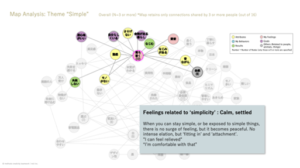Vision
To be the best team at driving the future development of CX, we seek to enable our clients, through a human-centered approach, to achieve sustainable business growth and become inclusive organizations where people learn, connect, and play.
Latest Topics

Spotlight: mct’s Global Partnership with Olson Zaltman
Since 2010, mct has held the license to use ZMET from Olson Zaltman. While ZMET has been actively adopted by leading companies in Europe and North America, mct is the only ZMET licensee in Japan. We are able to conduct ZMET surveys and provide in-depth unconscious exploration of Japanese customers thinking for client projects.
What is ZMET? Eliciting the emotions and thoughts that form in the unconscious mind
ZMET interviews are used to explore the deeper emotions and thoughts that unconsciously shape consumers’ behavior. Our ZMET-certified interviewers explore the consumer’s deep metaphors in the unconscious. From the deep metaphors, the unconscious components that influence consumers’ choices are verbalized. We will utilize this information in our strategy to create products and services that consumers will choose.
Global Partner Sessions
Beginning earlier this year, Olson Zaltman launched a quarterly meet-up for its global partners to get to know each other and exchange ideas and experience.
For the first global partner session, the theme was to highlight different ways ZMET can be adapted to client needs, from promotional messaging for organic farming to service design around the future of feminine hygiene. As part of this, mct was asked to present one of our ZMET projects – a multi-client survey conducted around the theme of “simple” for Japanese households with and without children.
Although a multi-client ZMET survey is still rare in other countries, mct has successfully introduced this format several times now, creating a unique opportunity for client participants to share insights across industries and spark potential collaborations.

Images from the multi-client ZMET report on “Simple”
During the global sharing session, the deep metaphors and insights gleaned from the ZMET study of “simple” were met with strong interest from our partners in Brazil and France. Some quoted Leonardo da Vinci’s famous quote, “Simplicity is the ultimate sophistication,” and others focused on the relationship between simplicity and the minimal aesthetic. Preconceived notions of what simplicity means for Japanese people were placed into a richer contextual understanding, and it led to an interesting conversation of what simplicity might mean, and why, for different people in different markets.
As these remote global sessions continue, mct has enjoyed being able to meet up with global partners, and compare diverse perspectives from research conducted around the world. Our focus at mct is to go beyond traditional research to go deeper and uncover fresh insights into our clients’ business challenges.
One-on-One Conversation With James Forr
Following up with OZ in between partner sessions, mct’s Shoko Strang was able to connect with Olson Zaltman’s James Forr recently to share with us some case studies using ZMET. James has conducted more than 1,400 ZMET interviews, and has directed many large-scale projects for Pepsi, IBM, and Bank of America.
Thinking about how metaphors are internalized as part of our thinking, a good example to start with “balance”. Early in life we learn to sit, crawl, walk, and run, and we gradually build a history of experience with balance. We learn that keeping our balance is a good thing, and conversely, losing our balance may be a bad thing. In this way, we use “balance” metaphorically in other situations, and it shapes how we might behave in situations that are not necessarily related to physical balance. We continue to use our past physical experiences (in the form of a metaphor) to learn new things throughout our lives. When it comes to understanding consumers, it makes sense to explore these underlying metaphors and their connections, to understand what factors which drive behavior beneath the surface of verbalized, conscious thoughts.
Watch a short clip of our conversation with James! ▷▷▷https://vimeo.com/537576478
Shoko and James also discussed the importance of emotion in B2B buying decisions, and various challenges of building an emotional brand in B2B. Because B2B marketing tends to rely on rational arguments, it’s often the case that emotional arguments are difficult to make – not that emotional factors are irrelevant.
James suggests that organizational personnel have a fear of making the wrong choice, a need for reassurance before and after the purchase, and a desire to be seen as heroes in the organization.
Below are three examples of marketing activities that successfully incorporate emotions.

Caterpillar
The “Let’s Do the Work” campaign makes blue-collar workers who build roads and office buildings into heroes by setting them apart in different markets around the world. The campaign increased brand favorability by 18%.
IBM
Now in its fourth year, “Call for Code Global Challenge” is a global contest that invites developers to come up with technology-based solutions to solve social problems such as natural disasters. These solutions are built on IBM’s open source software tools. Currently, it boasts a branded community of more than 300,000 developers.
SAP
By making some of its products available for free during the pandemic, SAP alleviated some of the business challenges associated with COVID, such as fears of global supply chain disruptions and concerns about remote work. This has paid off, with new supplier registrations in SAP Ariba Discovery increasing by 4,000 percent.
Whether you’re buying breakfast cornflakes at the grocery store, or putting together a PO for new bulldozers, people are people, and every decision has an emotional component to it.
Original Japanese articles: https://media.mctinc.jp/blog/topic/zmet
